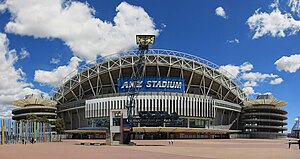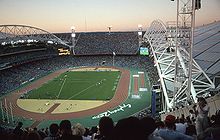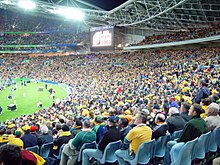ANZ stadium
| ANZ stadium | |
|---|---|
| Olympic Stadium Homebush Stadium |
|

|
|
| The ANZ Stadium in Sydney | |
| Earlier names | |
|
Stadium Australia (1999-2002) |
|
| Data | |
| place |
|
| Coordinates | 33 ° 50 '50 " S , 151 ° 3' 48" E |
| owner | Stadium Australia Group |
| operator | Stadium Australia Group |
| start of building | September 1996 |
| opening | March 6, 1999 |
| Renovations | 2001-2003 |
| surface | Natural grass |
| costs | 690 million AUD |
| architect | Bligh Lobb Sports Architects |
| capacity | 81,500 seats (with oval playing field) 83,500 seats (with rectangular playing field) 110,000 seats (during the 2000 Olympics) |
| Societies) | |
|
|
| Events | |
|
|
The ANZ Stadium is a multi-purpose stadium in Sydney Olympic Park . As the main stadium for the 2000 Summer Olympics, it was named Stadium Australia . From 2002 to December 2007 it was called Telstra Stadium by the Australian communications company Telstra . As the venue for the 2015 Asian Football Championship , it was named Stadium Australia again .
The stadium is located in Homebush , a suburb to the west of Sydney . It was built as an Olympic stadium on the occasion of the 2000 Summer Olympics and completed in March 1999.
The original audience capacity was 110,000. After the major events in 2000, the stadium was rebuilt between October 2001 and October 2003. The two back-door stands in the upper tier were demolished and the curves covered with roof elements. Since then, the oval playing field only seats 81,500 spectators. If the playing field is converted into a rectangle, the capacity can be expanded to 83,500.
Building history
The architectural office Bligh Lobb Sports Architects was responsible for the design of the stadium . The construction costs for the stadium, which took place between September 1996 and March 1999, amounted to nearly 700 million Australian dollars.
After the Olympic Games, the stadium was modified in October 2001, which cost around 80 million Australian dollars again. The main focus of the renovation work was the creation of an oval playing field, as required for Australian football and cricket . The roof was expanded and the official audience capacity reduced from 110,000 to 80,000.
Sports history

The sporting history of the stadium can be divided into three sections. First the beginnings up to the Olympic Games, then the Games themselves and finally the phase after the stadium renovation.
Beginnings
At the opening on March 6, 1999, two rugby league games of the National Rugby League took place. The games Newcastle Knights against Manly-Warringah Sea Eagles and Parramatta Eels against St. George Illawarra Dragons followed 104,583 spectators, which meant a new world record. The official opening took place in June 1999 with a game between the Australian national football team and a FIFA All-Star selection.
On August 7, 1999, a preparation game of the National Football League was played. The Denver Broncos played against the San Diego Chargers . It was the first and to date only American Bowl game that was played in Australia . The record number of spectators at a rugby league game set up on the opening day was subsequently improved several times. The current record held by this stadium was set in 2000 and is 109,874 spectators.
2000 Summer Olympics
The ANZ Stadium was the Olympic Stadium for the 2000 Summer Olympics under the name Stadium Australia . With an official audience capacity of 110,000, it was the largest Olympic stadium of all time. The opening and closing ceremonies were held there. It was also the venue for the athletics competitions and the final of the soccer tournament. The final between Cameroon and Spain was watched by 104,098 spectators. With 112,524 spectators, the fourth day of the athletics competitions was the most popular of the sport. The record at these Olympic Games was set at the closing ceremony with 114,714. It was the largest number of spectators in this stadium and was not surpassed even after the end of the 2000 Summer Olympics. As a result, the 2000 Summer Paralympics took place.
After the renovation
On October 26, 2002 the Speedway World Championship Grand Prix of Australia took place at Telstra Stadium as part of the Speedway Individual World Championship.
After the renovation work, the ANZ Stadium was one of the venues for the 2003 Rugby Union World Cup . The semi-finals and finals took place there. In the final, the Australian team lost to the English.
On November 16, 2005, the playoff second leg for participation in the 2006 World Cup in Germany between the winner of the Oceania qualification, Australia, and the fifth of the South American qualification, Uruguay, was played in the ANZ Stadium. Uruguay won the first leg 1-0, the second leg ended with the opposite result. So it came to penalties, which the Australians won 4-2. During the 2015 Asia Cup, it will be the venue for seven games, including a semi-final and the final.
In November 2017, the state of New South Wales announced the demolition of the Olympic Stadium from 2000 to replace it with a new building. But these plans were replaced by a planned refurbishment of the facility for A $ 810 million. At the end of May 2020, the state's prime minister , Gladys Berejiklian , withdrew from the project. The population was behind the plans and the government was about to award contracts. Due to the health and economic consequences of the COVID-19 pandemic, it makes no sense. The project's budgeted funds will flow into a new A $ 3 billion infrastructure and job acceleration fund for the troubled economy.
Regular sporting events
The National Rugby League hosts its final at the ANZ Stadium. The stadium is also used by the teams Wests Tigers , Canterbury-Bankstown Bulldogs and South Sydney Rabbitohs as a venue for home games. The State of Origin rugby league games between the states of New South Wales and Queensland are also played in this stadium. The Sydney Swans also use the stadium as a venue for some of their home games in the Australian Football League .
Events
The ANZ Stadium is also used as a venue for concerts and other events. As early as February 25, 1998, U2 performed on their Popmart Tour , and on November 10, 11 and 13, 2006 on their Vertigo Tour there. The Rolling Stones have also played in this stadium . On July 15, 2008 the opening service of the XXIII. World Youth Day held in the stadium.
See also
Web links
- ansstadium.com.au: Official website of the stadium (English)
- stadionwelt.de: picture gallery
Individual evidence
- ↑ NSW abandons ANZ Stadium redevelopment. In: austadiums.com. May 31, 2020, accessed on June 13, 2020 .





